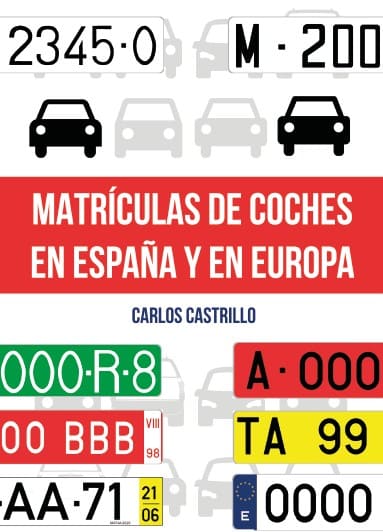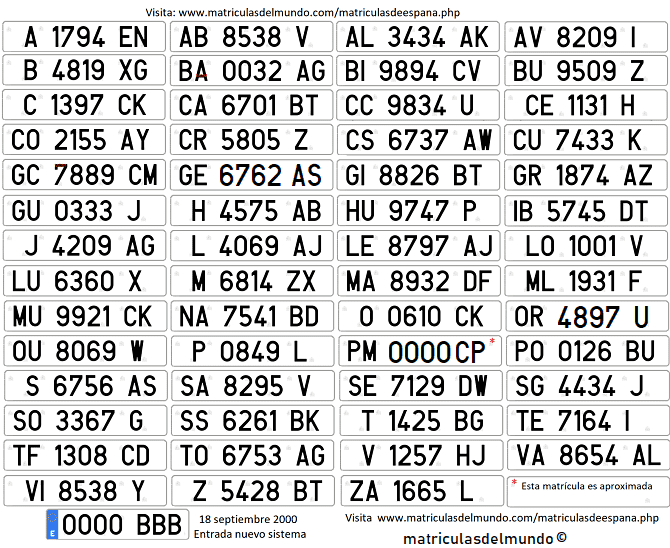The History of Car License Plates in Spain updated
Discover what Spanish license plates look like, their registration dates, and special types. Discover the differences between de current ordinary Spanish license plate system 0000BBB and the previous regional license plate system. In Spain, there are over 22 different types of license plates, encompassing ordinary cars, motorcycles, official and special vehicles, using various colors and formats. Moreover, there are several curiosities that make the Spanish system one of the most complex and well-crafted in the world. In the Spanish ordinary license plate system, the vowels A, E, I, O and U are not in use. Ñ and Q are also not in use. Find out more below.
Get the book about license plates in Spain
Buy the book Cars License Plates in Spain and Europe from Carlos Castrillo in Spanish. We provide you all the details about how to buy it.
Types of Spanish car license plates in the last 120 years
The first license plate issued in Spain was on October 31, 1900 with the number plate PM-1, with the regional code from Palma de Mallorca. (Read more about it below) During the next years, there were some changes regarding the regional codes. In 1971, a brand new typography started to be in use for the new issued numerations. In addition, this system added a letter at the right side of the Spanish license plate and limited the numbers in the plates up to four. This system is known as Grafías Finas (tranlated into English as fine graphics). In 1986 started the use of a more standardized typeface thicker than the previous that is still in use. On September 16, 2000, before the plate 9999ZZ was reached, a whole new system began to be used. This is the current system of license plates for Spain, which is not using any regional code. The configuration since then is four numbers and three letters like 1234BCD.
| Period of time | Example of Spanish plate |
|---|---|
| Since 2000 (Current system) |  |
| Between 1987 and 2000 (with euroband) Read the history about Spanish plates |
 |
| Between 1987 and 2000 (without euroband since 2000 on reregistrations) |
 |
| From 1971 to 1987 With thin lettering called "grafías finas" |
 |
| Until 1971 (no letter at the end) Various types of typography used |
 |
Ordinary car license plate of the current system since 2000
Since Monday, September 18th, 2000, every license plate in Spain uses a format without regional codes, consisting of four numbers from 0000 to 9999 and three letters from BBB to ZZZ. A space is shown between them, and vowels, Ñ, and Q are omitted to avoid possible confusion (letter Ñ and N for example) and unpleasant sounds. On the left side of the Spanish plate, a blue strip called the euroband is displayed, showing the flag of the European Union and the international identification code of Spain, the letter E.
When the current Spanish license plate system was introduced in the year 2000, it was estimated to have a usage of approximately 40 years. The system that will follow is not yet known, but some possibilities are 000BBBB or BBB0000.
Size of the Spanish license plates
The size of the current Spanish license plates is the standard European size of 520 x 110 mm. In the following table you can find all the sizes in use at the moment in Spain and also in the previous Spanish license plates systems. The license plates without eurobande on the left were around two centimeters narrower than the ones with the blue band. In 1972, in addition to the new typography, Spain adopted a standard size for license plates of 500 x 110 mm.
| License Plate Type | Dimensions (in millimeters) | Example |
|---|---|---|
| Standard Long License Plate | 520 x 110 mm. |  |
| Standard Tall License Plate | 340 x 220 mm. | 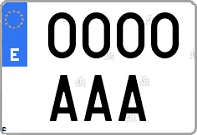 |
| Standard Long Front License Plate | 340 x 110 mm. |  |
| Standard Motorcycle License Plate | 220 x 160 mm. | 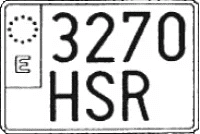 |
| Standard Old Long License plate | 500 x 110 mm. |
Special License Plates Currently in Use in Spain
Spain uses a large number of special license plates that you can consult below. If you click on the image or the text, you can discover much more information about each special license plate system.
Ordinary Special License Plate Type
 - Taxi and Vehicle-for-hire car (VTC in Spanish (Uber, Cabify, Bolt...)) License Plate
- Taxi and Vehicle-for-hire car (VTC in Spanish (Uber, Cabify, Bolt...)) License Plate
- Trailer and Semitrailer License Plate
- Moped License Plate
- Historic Vehicle License Plate
- Special Vehicle License Plate
Type of Spanish diplomatic license plate
- Diplomatic Corps License Plate
- Consular Corps License Plate
 - International Organization License Plate
- International Organization License Plate
 - Administrative Technician License Plate
- Administrative Technician License Plate
Temporary license plate type
- Temporary license plate for individuals
- Temporary license plate for new companies
- Temporary license plate for used companies
Type of Spanish state and military license plates
- National Police CNP license plate
- Guardia Civil PGC license plate
 - Ertzaintza license plate
- Ertzaintza license plate
- Mossos d’Esquadra license plate
 - General License Plate of the Canarian Police
- General License Plate of the Canarian Police
- Ministry of Development MF license plate
- Ministry of Environment MMA license plate
- State Mobile Fleet PME license plate
- Spanish Army ET license plate
- Spanish Air Force EA license plate
- Naval Force FN license plate
Other current types of special license plates
 - Royal House license plate
- Royal House license plate
- Allied Forces in Spain license plate
- American Forces in Spain license plate
 - Other special types of license plates
- Other special types of license plates
History of Spanish car license plates up to the year 2000
History of Spanish License Plates during the Second Half of the 20th Century (1971-2000)
The history of the Spanish car license plates up to the year 2000 is very interesting, but with a small number of changes in comparison with other countries. From 1971 to September 2000, Spanish license plates started with a provincial code of one or two letters, followed by four numbers from 0000 to 9999, and one or two letters from A to Z and from AB to ZZ. The highest reached were the letters ZX in Madrid and XG in Barcelona with the license plates M-6814-ZX and B-4819-XG.
The font style used up in the license plates to the present day was introduced in 1985. Prior to that, a "fine typography" (Grafías finas) was used, similar to the current one but with thinner strokes in the characters. The size of the plate was 500 x 110 mm. Until October 18, 1986, some die-cutting machines continued to use the previous system. After this date, a transition to the new font system became necessary.
Spanish License Plates in the Early 20th Century (1900-1971)
With the introduction of the first vehicles in Spain, there arose the need to individually identify each of them. From 1900 to 1907, all vehicles used two license plates, one from the municipality and the other from the Civil Government.
The first defined system for car license plates in Spain unified both types of plates previously used and was introduced in 1907. With this system, all plates were required to have black characters on a white background, starting with a regional code consisting of one, two, or three letters. Each vehicle was required to display two plates, one on the front and one on the rear. Years later, provinces with three characters in their abbreviation were changed to two-letter abbreviations.
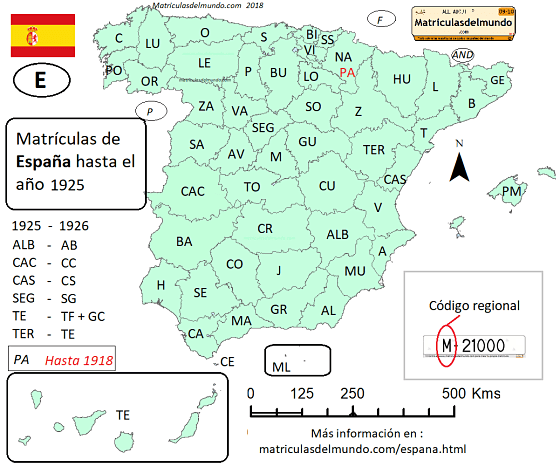
When was the first car license plate issued in Spain?
The first car license plate in Spain was on October 31, 1900. The first license plate issued in Spain was PM1. This car was a Clement quadracycle located in Palma de Mallorca (Balearic Islands), which by that time were using the regional code PM. In the same year 1900, three other license plates were registered throughout Spain, one in Cáceres, another in Salamanca, and one more in Palma de Mallorca. However, this first registered car was not the first car to drive on Spanish roads, as there is evidence of others doing so throughout the territory without a license plate.
In an international context, although the registration date was very early, by 1900 there were already several countries like Germany since 1896 and France since 1893 with established license plates systems. One of the earliest license plates in the world is believed to be the number "1G" on a car registered in 1893 in the region of Paris, France.
Provincial Codes in Spanish Car License Plates
From 1900 to 2000, Spain used a system based on provincial codes. The Spanish provincial license plate system was well-known in everyday life, and in numerous cases, references were made to some of the codes used in popular culture. The provincial code was always displayed in the first position for regular vehicles but could be displayed in the second position for "temporary tourist" license plates or even in the last position for special military license plates. Furthermore, in the former territories that Spain had in Africa (such as Western Sahara or Equatorial Guinea), there were distinct codes in use, for example SH, RM, FP. You can find the whole list of provinces in the following table, excluding the ones used in the former territories.
| Code | Province | Last license plate | Notes |
|---|---|---|---|
| AB | Albacete | AB 8538 V | ALB until 1926 |
| A | Alicante | A 1794 EN | |
| AL | Almería | AL 3434 AK | |
| O | Asturias | O 0610 CK | Province changes its name |
| AV | Ávila | AV 8209 I | |
| BA | Badajoz | BA 0032 AG | |
| B | Barcelona | B 4819 XG | |
| BI | Vizcaya | BI 9894 CV | |
| BU | Burgos | BU 9509 Z | |
| CA | Cádiz | CA 6701 BT | |
| S | Cantabria | S 6756 AS | Province changes its name |
| CC | Cáceres | CC 9834 U | CAC until 1926 |
| CS | Castellón | CS 6737 AW | CAS until 1926 |
| CE | Ceuta | CE 1131 H | |
| CR | Ciudad Real | CR 5805 Z | |
| CO | Córdoba | CO 2155 AY | |
| C | A Coruña | C 1397 CK | |
| CU | Cuenca | CU 7433 K | |
| GC | Las Palmas de Gran Canaria | GC 7889 CM | TE until 1926 |
| GI | Girona | GI 8826 BT | GE until 1992 |
| GR | Granada | GR 1874 AZ | |
| GU | Guadalajara | GU 0333 J | |
| H | Huelva | H 4575 AB | |
| HU | Huesca | HU 9747 P | |
| IB | Islas Baleares | IB 5745 DT | PM until 1997 PM Used BA for less than 10 years |
| J | Jaén | J 4209 AG | |
| LE | León | LE 8797 AJ | |
| L | Lérida | L 4069 AJ | |
| LO | Logroño | LO 1001 V | |
| LU | Lugo | LU 6360 X | |
| M | Madrid | M 6814 ZX | |
| MA | Málaga | MA 8932 DF | |
| ML | Melilla | ML 1931 F | |
| MU | Murcia | MU 9921 CK | |
| NA | Navarra | NA 7541 BD | PA until 1918 |
| OU | Ourense | OU 8069 W | OR until 1998 |
| P | Palencia | P 0849 L | |
| PO | Pontevedra | PO 0126 BU | |
| SA | Salamanca | SA 8295 V | |
| SS | Guipúzcoa | SS 6261 BK | |
| SG | Segovia | SG 4434 J | SEG until 1926 |
| SE | Sevilla | SE 7129 DW | |
| SO | Soria | SO 3367 G | |
| T | Tarragona | T 1425 BG | |
| TF | Santa Cruz de Tenerife | TF 1308 CD | TE until 1926 |
| TE | Teruel | TE 7164 I | TER until 1926 |
| TO | Toledo | TO 6753 AG | |
| V | Valencia | V 1257 HJ | |
| VA | Valladolid | VA 8654 AL | |
| VI | Araba /Álava | VI 8538 Y | |
| ZA | Zamora | ZA 1665 L | |
| Z | Zaragoza | Z 5428 BT |
Old special Spanish license plate systems
Spain has used a large number of special license plates of different types throughout its history. The first special license plate that appeared was in the first decade of the 20th century, when artillery license plates were created for military vehicles, consisting of the letters "ARTILLERIA" followed by a serial number starting from 1.
However, until the end of the Civil War, not much information is preserved, and even after 1940, there are still some unknown types of special license plates. It is worth noting that during some of the years when this tragic event took place, vehicle registrations in some highly populated provinces, such as Madrid, reached zero registrations in some months.
Old special Spanish license plates that are still seen
Here are the special license plates that, despite being from previous systems, are still in use, and it is not necessary to re-register old vehicles. They were in use until 1999, one year before the change happened to the ordinary system. Some exceptions are notified in the table.
| Abbreviation | Meaning: | More details/images |
|---|---|---|
| E | Special vehicle Especial | (No need for re-registration) Provincial code at the beginning 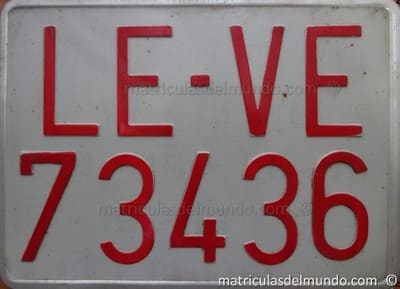 |
| R | Trailer Remolque | R at the end in black on red background. (No need for re-registration to the current system) Provincial code at the beginning
|
| VH | Historical Vehicle | From 1995 to 1999. Provincial code in the middle Format VH-A-0000 |
Old special Spanish license plates that are no longer in use
Here are the special license plates from Spain that are already not valid to be used in Spain. You can find all the codes in the following detailed table.
| Abbreviation | Meaning: | More details/images |
|---|---|---|
| - | Moped Moped | All plates were re-registered in 1999 and 2000 to the current ones.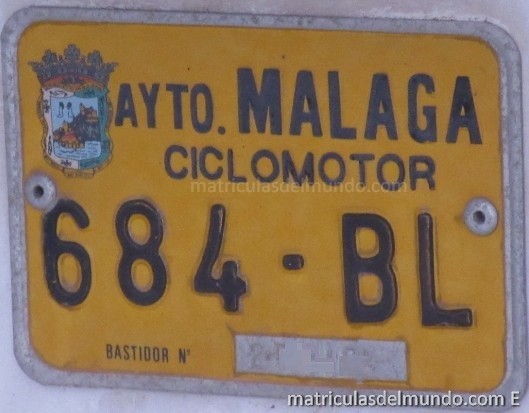 |
| CAT | Supply and Transport Commissioner Comisaría de Abastecimientos y Transportes | In use from 1941 to 1964 |
| CON | Construction | Used for machinery of public companies.
|
| CPN | National Police Companies Cuerpo de Policía Nacional | Since 1981. Later changed to DGP |
| DGP | General Directorate of Police Dirección General de la Policía | Until 2008 Later changed to CNP |
| FET | Traditionalist Spanish Phalanx Falange Española Tradicionalista | Later changed to SGM |
| FPA | Police | Later changed to CPN |
| Imp* | Importation | Green background. Starts with provincial code |
| ITV | Vehicle Technical Inspection | Used in exceptional cases. Example: M-ITV-1234 Green background |
| MOP | Ministry of Public Works Ministerio de Obras Públicas | From 1940 to 1999. Later changed to MF and MMA. Some vehicles still use the MOP abbreviation, even with the Euroband.
|
| P | Tests | White on red background. Square plate showing semester at the top. Provincial code in the first position.  |
| PMM | Ministry Fleet Parque Móvil de Ministerios | Until 1999. Later changed to PME
|
| PAT | Armed and Traffic Police | Later changed to FPA |
| PP | Oil Prospecting | |
| R | Temporary | White on green background
|
| SGM | General Secretariat of the Movement Secretaría General del Movimiento | Until May 1977 |
| T | Transportation | White on blue background. Square plate showing semester at the top. Provincial code in the first position. 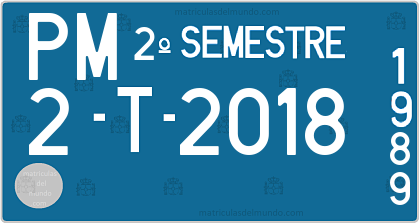 |
| T | Temporary Tourist Turista Temporal | 1963-2019 Since 1999, the letter T followed by four numbers and a series of three letters. (See news in detail)
 |
| TT | Land Transportation Transporte Terrestre | Black on red background. Trailers with special equipment. |
| Expo Sevilla | Seville Universal Exhibition | 1992. Until 1993 |
| JJOO Barcelona | Barcelona Olympic Games | 1992. Until 1993
|
| Find all the details in our new book about Spanish license plates with all the information explained | ||
Old special Spanish license plates before the Civil War
Before the Spanish Civil War (1936-1939), there were various systems of special license plates in Spain, primarily of a military nature, with variations throughout the years leading up to the war. Some of them are not recorded and there are not any evidence they existed or what they meant. In the following table you can find some of the most famous ones.
| Code | Identifies | Comment/Details |
|---|---|---|
| ARM | Rapid Military Motoring Automovilismo Rápido Militar | White on black background. Precedes ET, FN 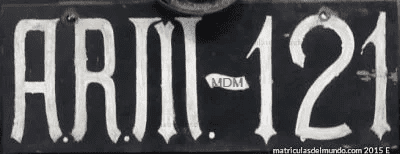 |
| ATM | Military Transport Motoring or Military Artillery | Previously "ARTILLERIANºx"
|
| AUT.M | Military Motoring Automovilismo Militar | Prior to ATM [AUT M.Nº0] Early 20th century.  |
| MCM | Military Motorcycle Motoring | White on black background. E.g., MCM-1234 |
| FME / RFME | (Royal) Spanish Motorcycling Federation |
License plates of Spanish territories in Africa
During the 20th century, Spain had under its control, like other European countries, colonies, protectorates, and later on, provinces, which had their own provincial codes, in addition to the Canary Islands, Ceuta, and Melilla. Each vehicle in each territory used a unique license plate with specific characteristics, which are explained below. The license plates of all these territories followed the same format as the rest of the provinces in Spain, starting with one, two, or three letters for the regional code. These codes are no longer in use and have been legally discontinued, requiring re-registration once the territory ceased to be part of Spain.
However, in addition to the provincial license plates, some of these territories had their own special license plates.
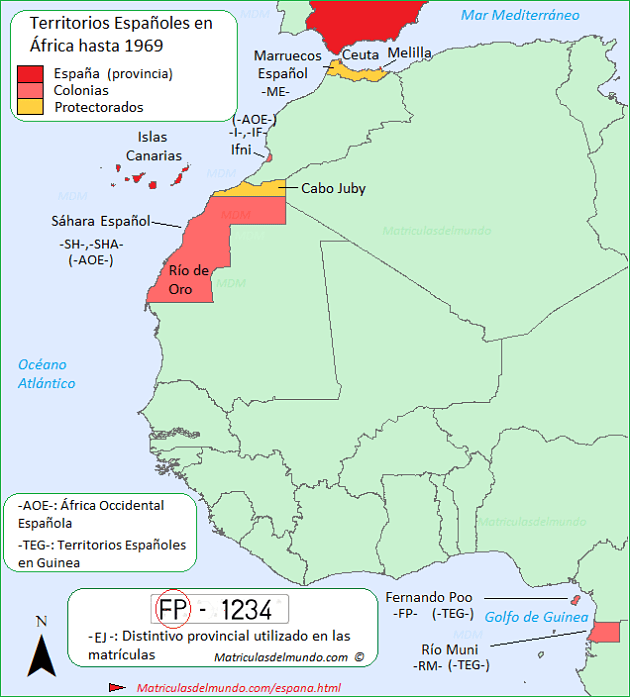
Provincial codes in the old license plates of colonies, provinces, and protectorates
In the case of Sahara (SH), the license plates eventually adopted a letter in the last position with the 1971 change. For example, SH-1234-A. You can read more information about this en the book about license plates.

| Code | Identifies | Notes |
|---|---|---|
| AOE | Spanish West Africa | Later I and SH |
| I - IF | Ifni | Previously AOE |
| FP | Fernando Poo | Previously TEG |
| ME | Spanish Morocco (Protectorate of) Marruecos Español (Protectorado de) | |
| RM | Rio Muni | Previously TEG |
| SH | Sahara | Previously SHA, AOE |
| TEG | Spanish Territories in Guinea Territorios Españoles en Guinea | Later divided into FP and RM |
Diplomatic codes in Spanish license plates CD, CC, OI and TA
How are the Spanish diplomatic license plates? You can check all the information above and in the Spanish version of this page. The first group of one, two or three numbers, identify the country, territory or organization. Below, you can find the whole updated list of codes for the diplomatic license plates from Spain.
| Codes for Diplomatic License Plates: CD, CC, OI, and TA in license plates from Spain | ||
|---|---|---|
| 1-Vatican | 2-Germany | 3-Saudi Arabia |
| 4-Algeria | 5-Argentina | 6-Australia |
| 7-Austria | 8-Belgium | 9-Bolivia |
| 10-Brazil | 11-Bulgaria | 12-Cameroon |
| 13-Canada | 14-Colombia | 15-South Korea |
| 16-Ivory Coast | 17-Costa Rica | 18-Cuba |
| 19-Czech Republic | 20-Chile | 21-China |
| 22-Denmark | 23-Ecuador | 24-Egypt |
| 25-El Salvador | 26-United Arab Emirates | 27-United States |
| 28-Philippines | 29-Finland | 30-France |
| 31-Gabon | 32-Great Britain | 33-Greece |
| 34-Guatemala | 35-Equatorial Guinea | 36-Haiti |
| 37-Honduras | 38-Hungary | 39-India |
| 40-Indonesia | 41-Iraq | 42-Iran |
| 43-Ireland | 44-Italy | 45-Japan |
| 46-Jordan | 47-Kuwait | 48-Lebanon |
| 49-Libya | 50-Morocco | 51-Mauritania |
| 52-Mexico | 53-Nicaragua | 54-Nigeria |
| 55-Norway | 56-SMOM | 57-Netherlands |
| 58-Pakistan | 59-Panama | 60-Paraguay |
| 61-Peru | 62-Poland | 63-Portugal |
| 64-Kazakhstan Formerly East Germany |
65-Dominican Republic | 66-Romania |
| 67-Syria | 68-South Africa | 69-Sweden |
| 70-Switzerland | 71-Thailand | 72-Tunisia |
| 73-Turkey | 74-Russia Formerly Soviet Union |
75-Uruguay |
| 76-Venezuela | 77-Serbia Formerly Yugoslavia |
78-Democratic Republic of the Congo |
| 79-Antigua and Barbuda? | 80-Slovakia | 81-Qatar |
| 82-Croatia | 83-Israel | 84-Malaysia |
| 85-Angola | 86-Luxembourg | 87-Guinea Bissau? |
| 88-Bangladesh | 93-Gambia | |
| 94-Cyprus | 96-Guinea | 101-Malta |
| 102-Monaco | 103-Nepal | 104-New Zealand |
| 105-San Marino | 107-Senegal | 116-Oman |
| 118-Yemen | 122-Vietnam | 124-Cape Verde |
| 128-Albania | 131-Lithuania | 132-Latvia |
| 133-Slovenia | 134-Mali | 135-Georgia |
| 139-Belarus | 140-Andorra | 142-Bosnia and Herzegovina |
| 143-Ghana | 144-Ukraine | 145-Macedonia |
| 148-Estonia | ||
| Codes from 150 to 200 (Organizations) | ||
| 150-International Olive Oil Council | 151-Ibero-American Education Office | 152-World Tourism Organization |
| 153-European Communities Commission | 155-League of Arab States | 157-Ibero-American Cooperation Secretariat |
| 159-International Labour Office | 160-International Commission for the Conservation of Atlantic Tunas | 162-European Space Agency |
| 163-UNHCR | 164-Ibero-American Youth Organization | 200-General Delegation of Palestine |
| 300-European Union Intellectual Property Office In Alicante |
303-European Union Satellite Centre | 304-NATO |
| 307-Andean Development Corporation | 309-United Nations Office for Water | 310-ITER (Fusion for Energy) |
| 311-COMJIB (Conference of Ministers of Justice of Ibero-American Countries) | 312-International Organization for Migration (IOM) | 314-United Nations International Technology and Communications Centre |
| 320-World Food Programme | ||
| Codes +400 (CD-CC) | ||
| 400-Kenya | 405-Sudan | 406-Afghanistan |
| 410-Moldova | 411-Mozambique | 414-Uzbekistan |
| 415-Armenia | 416-North Korea | 419-Azerbaijan |
| 426-Montenegro | ||
| License Plate Generator (More countries and territories) | |||||||||||||
|---|---|---|---|---|---|---|---|---|---|---|---|---|---|
| The image will be generated here: |
 |
||||||||||||
| To create the characteristic half-height dot in the provincial license plates, use the . key. | |||||||||||||
| Current system (2000-present) - for dash  |
|||||||||||||
| Current system (2000-present) - 9 characters |
|||||||||||||
| Standard front long plate (Narrow) (2000-present) |
|||||||||||||
| Previous system (1987-2000)  |
|||||||||||||
| Previous lettering (Until 1987)  You can create a small space with the space bar and a large space with _ |
|||||||||||||
| Previous lettering Before the fine lettering system Maximum 8 characters |
|||||||||||||
| Standard square license plate
▼ Click the dropdown to view different eras ▼
Current (since 2000)
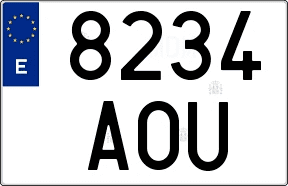
1987-2000
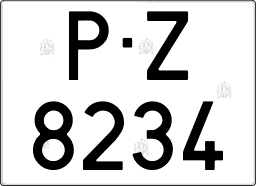
Fine lettering (pre-1987)
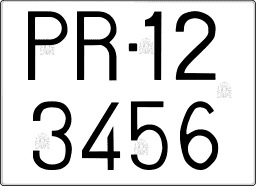 | |||||||||||||
| Type of license plate special vehicle
▼ Click the dropdown to see all available types ▼
Current and previous

Current high format
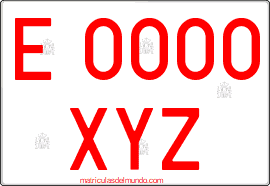
Previous format
Previous high format
Special license plates (Taxi, trailer, Temporary, temporary, temporary tourist, moped, ertzaintza) |
▼ Click on the dropdown to see all available types ▼
Taxi and rental with driver

Trailer: Current (Since 1987)

Trailer: Current alta

Trailer: Grafía fina (hasta 1987)

Temporary
(1999-Current) 
Temporary alta

Temporary
(1999-Current) 
Temporary alta
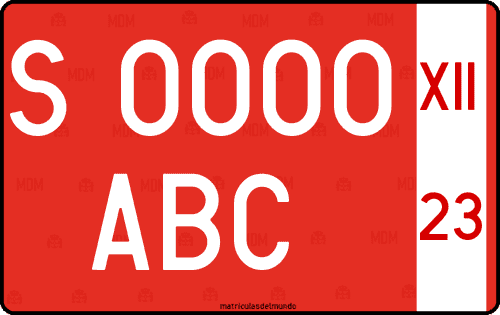
Temporary Tourist
(1999-2018) 
Moped (Since 1999)
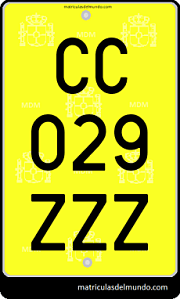
Moped (Since 1999)
green background
Moped (Since 1999)
red background 
Moped (Since 1999)
white background 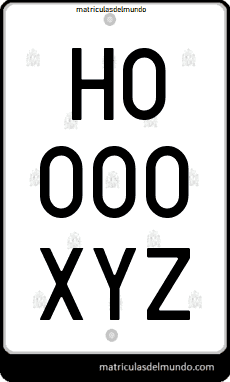
Moped larga delantera
(Estrecha Current) Cuadriciclo 
Ertzaintza
 Diplomatic License Plate | 
▼ Click the dropdown to see different time periods ▼
Administrative Technician

International Organization

Diplomatic Corps
 Olympic Games of Barcelona |
1992 
|
Test and Transportation License Plate |
▼ Click the dropdown to see different time periods ▼
Old Test License Plate
(1987-1999) 
Old Transportation License Plate
(1987-1999)  Transportation Card Diamond |
|
TARA and PMA Plate |
Maximum Authorized Weight 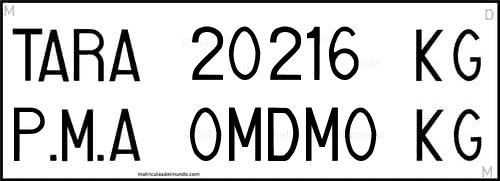
|
| ||||

